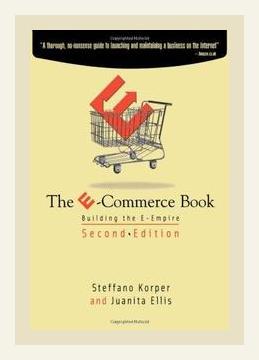Technology and Digital TransformationE-commerce
The E-commerce Book: Building the E-Empire by Steffano Korper and Juanita Ellis – Summary
“The E-commerce Book: Building the E-Empire” by Steffano Korper and Juanita Ellis, published in 2000, is a comprehensive guide to understanding and implementing e-commerce strategies effectively. It delves into the foundational elements, strategic planning, technological infrastructure, and execution techniques necessary for a successful e-commerce venture. This summary encapsulates the major points of the book, organized into several key sections, with concrete examples and specific actions to implement the advice provided.
1. Understanding E-Commerce Fundamentals
Key Point: E-commerce is not merely a technological change but a profound alteration in how businesses function and consumers behave.
Example: The book explores how Amazon, initially a small online bookstore, revolutionized the retail industry with its e-commerce model.
Action: Perform a SWOT analysis to understand your business’s strengths, weaknesses, opportunities, and threats in the context of e-commerce. This will help identify areas that need focus and improvement.
2. Market Research and Strategy Planning
Key Point: Comprehensive market research is essential for developing an effective e-commerce strategy.
Example: The authors discuss a fictional company, “TechMart,” that successfully implemented an e-commerce strategy after conducting thorough research on consumer behavior, market trends, and competitor analysis.
Action: Conduct surveys and focus groups to gather data on potential customers. Use tools like Google Analytics to track website visitor behavior and make informed decisions based on this data.
3. Building the E-Commerce Infrastructure
Key Point: A robust technological infrastructure is the backbone of any successful e-commerce platform.
Example: The book provides a case study of an electronics retailer that invested in scalable cloud infrastructure, ensuring their website could handle traffic spikes during peak seasons.
Action: Choose scalable cloud solutions like AWS or Microsoft Azure to ensure your e-commerce platform can handle varying levels of traffic efficiently.
4. Website Design and User Experience
Key Point: User experience (UX) and intuitive website design are crucial for retaining customers and driving sales.
Example: The authors highlight the importance of clean, functional design with examples from successful websites like eBay and Dell, which prioritize ease of navigation and quick access to products.
Action: Implement user-friendly design principles using tools such as A/B testing to optimize your website layout and enhance user experience.
5. Payment Systems and Security
Key Point: Secure and convenient payment systems are essential for gaining customer trust and ensuring smooth transactions.
Example: The book details how PayPal’s integration into e-commerce sites has provided secure, versatile payment options, reducing friction during the checkout process.
Action: Incorporate multiple payment gateways (e.g., PayPal, Stripe) and ensure PCI compliance to secure transaction data and build customer trust.
6. Logistics and Supply Chain Management
Key Point: Efficient logistics and supply chain management are critical for timely delivery and customer satisfaction.
Example: The authors discuss Walmart’s success with its highly optimized supply chain and logistics processes, enabling quick and reliable delivery.
Action: Partner with reliable logistics providers and invest in inventory management systems to streamline order fulfillment and reduce delivery times.
7. Online Marketing and SEO
Key Point: Effective online marketing and search engine optimization (SEO) are vital for driving traffic to your e-commerce site.
Example: The book describes how a small fashion retailer grew its online presence by effectively using social media marketing and SEO strategies to reach a broader audience.
Action: Develop a comprehensive online marketing strategy that includes content marketing, social media engagement, and SEO practices such as keyword research and link building.
8. Customer Service and Support
Key Point: Exceptional customer service can differentiate your e-commerce business and foster customer loyalty.
Example: The authors highlight Zappos’ commitment to superior customer service, which has become a significant differentiator in the competitive online retail market.
Action: Implement 24/7 customer support through live chat, email, and phone, and ensure your support team is well-trained to handle customer inquiries promptly.
9. Legal and Ethical Considerations
Key Point: Navigating legal and ethical issues is necessary for maintaining a reputable and compliant e-commerce business.
Example: The book provides examples of companies that faced legal challenges due to inadequate knowledge of international e-commerce laws.
Action: Consult with legal experts to ensure your e-commerce business complies with relevant laws and regulations, including data protection, consumer rights, and international trade laws.
10. Measuring Success and Continuous Improvement
Key Point: Regularly measuring performance and seeking continuous improvement are essential for long-term success in e-commerce.
Example: The authors describe a continuous improvement cycle implemented by a tech startup, which regularly tracked key performance indicators (KPIs) and made data-driven decisions to enhance their operations.
Action: Use analytics tools to monitor key performance metrics such as conversion rates, average order value, and customer acquisition cost. Regularly review these metrics and implement changes based on the insights gained.
Conclusion
“The E-commerce Book: Building the E-Empire” by Steffano Korper and Juanita Ellis offers a detailed guide to excelling in the e-commerce industry. By understanding and implementing the principles outlined in this book, businesses can build a robust online presence, optimize their operations, and achieve long-term growth. This structured summary provides concrete actions and examples to help you apply the advice in a practical context, ensuring that your e-commerce venture stands out in the competitive digital marketplace.
